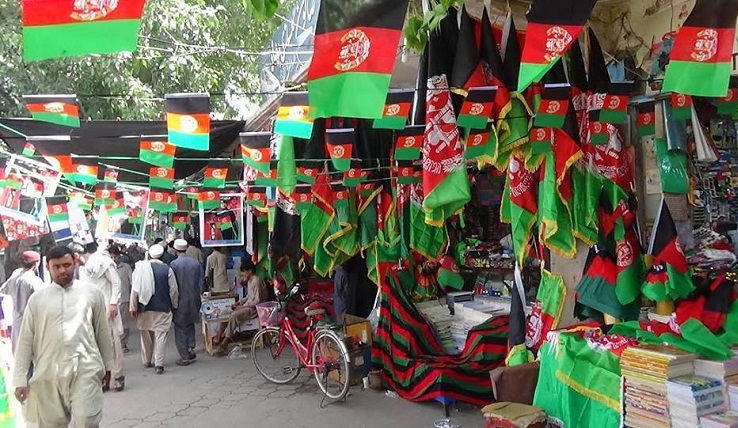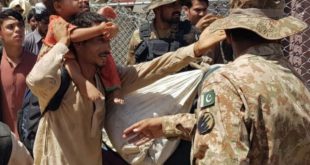AT Special Report-KABUL: Afghans will celebrate 97th Independence Day on Thursday with great zeal. However, it also poses some basic questions such as: Are we independent? Where do we stand since independence in 1919?
We all know the answers but prefer to dodge ourselves because we are good at running away from realities. There is no denying that Afghanistan still tramps on in poverty. The social infrastructure is in tatters. Believe or not, but it the reality we have to accept and deal with. Over 50 percent of population is prone to domestic violence, street harassment, physical and sexual abuse, and discrimination. The society in general and the government in particular has pushed girls and women to the corner—slowing speed of the progress. Hundreds of women are widows. Exact number is unknown because in a conservative society such as we have, people do not collect and share data that could be associated to their families.
Education sector
Around two million children have been pushed into the streets to work and augment their families’ income. What did push them into works instead of being in schools? Here again the biggest factor is the ongoing conflict.
In 2014, the Ministry of Education claimed that it has annually covered an average of 500,000 people with literacy programs. Two years ago, around 796,000 people, aged over 15, were attending around 31,840 courses.
Seven million people still are illiterate. Currently around 36 percent countrymen are educated while the national average for literacy stands at 20 percent for women as compared to 50 percent for men. As we move away from the main cities, particularly Kabul, Balkh, and Herat followed by Badakhshan, and into rural areas, in some provinces only one percent of women were found to be literate.
Health sector
Although the health ministry claimed of better health facilities at the hospitals but public is not satisfied with these facilities as doctors are unable to find out the very reason behind their sickness. Misdiagnosing in private and government-owned hospitals is a common phenomenon leading towards several and severe health problems. The question which strikes mind is that millions of US dollars have been spent on health sectors since 2001, then why public has been denied access to standard healthcare and remote areas were ignored.
Lack of female health workers is a serious challenge that had not been addressed till date. Only 22 percent of doctors are women, while 21 percent of the nurses are ladies, according to the ministry data. Presently, 11,037 women health workers provide essential basic health services and health trains to women around the country.
In June, the Monitoring and Evaluation Committee (MEC) said in a report that health sector had lost people’s trust and donors due to corruption.
The MEC and ministry of public health have carried out a survey, interviewing people in Kabul and 12 provinces.
“Survey reveals that corruption exists extensively in the health ministry, and the MEC presented recommendations to the ministry to address the issues,” said Technical Advisor of the Survey Matthew Rodieck.
He said that lack of information regarding policies, no exact assessment about contracts, graft in food, medicine and fuel, misusing ambulances, duties and health equipment and institutions are the common challenge in the health sector interviewees complained.
Discrimination with patient in health sectors, double behave of doctors with patient, nepotism in hiring of staffs were other problems caused decrease of people and donor trust over health sector.
Moreover, different types of diseases are common but the health minister has no comprehensive plan to save public lives.
Measles outbreak is also increasing in the country as at least 445 cases of the disease have been registered this year which is much higher than the past year’s figures—581 cases in the whole year.
Afghan and international health bodies believe that the diabetes has had a dramatic rise in Afghanistan, threatening the people life more than any time in the past.
In April this year, the deputy public health minister Ahmad Jan Naeem said that if diabetes was not controlled, it can cause complications including heart attacks, strokes, kidney failure, blindness, and foot ulcers that can lead to amputations.
It has remained largely unnoticed and untreated in Afghanistan with around 2.7 million people affected with, according to the World Health Organization in Afghanistan.
WHO Representative, Suprya said that the burden of diabetes is felt by individuals, families, communities and the health sector but much of this burden is avoidable. Many cases of diabetes can be prevented, and all can be detected and managed.
Malnutrition is another problem. Over 40 percent of children suffer from malnutrition and around 95 percent of women faced with lack of vitamin D fortification in Afghanistan.
According to statistics of the Ministry of Public Health and the World Health Organization, every year 60,000 people are affected with tuberculosis (TB). Although, the disease can be controlled but yet it kills 14, 000 people every year in Afghanistan.
Drug addiction
According to a survey conducted by the International Narcotics and Law Enforcement Affairs (INL) with oversight by the institutional Review Board of the Ministry of Public Health (MoPH) the number of the illicit drug users rose up to three million.
The health ministry said that out of three million drug users, 1.4 million are addicted to drugs and 1.6 million others are either using or linked with drugs.
The children are not using drugs but they are passive users because their parents are addicted, the minister said, adding that the survey was conducted in two phases: urban study was conducted in 2012 and rural study completed this year, which gives a nationwide profile of drug use in Afghanistan.
Another survey report “Afghanistan Drug Report” reveals that 12.6 percent of adults in Afghanistan are drug addicts.
The survey has been conducted by the Ministry of Counter Narcotics in a joint venture with the United Nations Office on Drugs and Crime (UNODC). Around 1.9 to 2.4 million (12.9 percent) adults in the country are addicts.
There are 123 addicts’ rehabilitation centers in the country which have the capacity of treating only 10.7 percent of drug users.
When the government is searching for pleasing opportunities in peace process and diplomacy, another news report tells about staggering numbers of female drug addicts. There are up to 90,000 female addicts in the country.
According to the eye-opening statistics of Ministry of Counter Narcotics, since 2009 the numbers of drug users is on rise. As per the statistics, though not exact and updated, the number of addicts increased from 1.5 million (in 2010) to 3.5 million. There were over three and a half million addicts in 2015. Some of them are in the category of ‘passive addicts’ as they are exposed to the harmful substances. Thousands of children are placed in this category.
Sadly, majority of the addicts are young people, under the age of 39.
Women in Afghanistan
The unending circle of bloodshed and mayhem which span over three decades had made hundreds of women widows. Most of them have lost the sole bread earners. The war which has no end in sight had brought darkness into lives of many women by making them widows.
According to the official statistics—which are always incomplete due to inaccessibility of the officials to insecure areas— the total number of widows in the country is 500,000. The data seems to be inconclusive, but it is shocking. The Ministry of Labor and Social Affairs said that 70,000 widows fall in the category of those who have lost the only bread-earner.
The ministry claims that 37 percent of widows are employee of different organizations, and 50 percent are involved in making and selling of handicrafts. However, such statements are far from truth.
Widows are often seen as a burden on the society. The government is not providing work opportunities to them. It is the private sector that provides jobs to the widows. Unfortunately, most of them are uneducated so living in extreme poverty. Most of the vocational programs are short term and limited to only secure cities which are very few.
According to a report of the Independent Human Rights Commission of Afghanistan (AIHRC), 4,873 cases of violence against women were registered in 2014. As many as 6,611 cases of violence of women were reported in 2013 and 5,701 in 2012. Fresh report of the AIHRC still to be released, but the available figures show a slight drop due to awareness about women’s rights. However, a long road is still ahead to eliminate violence against women. Most of the violence cases were about physical violence, especially torture. Out of the total registered cases, 1,268 were related to physical violence—30.1 percent of the total cases.
At least 412 cases were related to sexual abuse, and 1,482 cases were related to verbal and psychological violence. Looking at the data it is clear that physical violence is common in the country, because 87 cases were related to injuries, 38 others to forced labor, and 19 cases were about killing of women. Thirteen cases were about setting women on fire. In 11 cases of violence against women, one or more body parts of the victims were chopped. In 2014, 92 cases of honor killings were reported. A total of 162 women lost their lives in the same year due to rampant violence and the culture of impunity. Between 2011 and 2013, 243 cases of honor killings were reported. Most of the honor killings cases in 2013 were registered in Herat, Paktia and Nangarhar provinces. Herat is on the top of list when it comes to honor killing as 44 cases out of 92 were reported in the western province in 2014, followed by Balkh, Kandahar, Paktia, Nangarhar, Faryab, Helmand, Kunduz and Uruzgan provinces.
Child labor
Children are the worst affected segment of the society like women. There are thousands of child in the country who are living in miserable condition because most of them neither have access to education nor to basic health facilities. Large numbers of children are forced to work hard to earn bread for siblings. They see no ray of hope. Insecurity also adds to their problem. A large number of these migrant children are doing hard work to improve their family’s income so they could live for another day. They are prone to sexual assaults at the work environment, but yet they fight for their survival.
“They perform tasks that could result in illness, injury, or even death due to hazardous working conditions and poor enforcement of safety and health standards. Many children who work under those conditions combine the burdens of a job with school, or forego education altogether. Working compels many children in Afghanistan to leave school prematurely. Only half of children involved in child labor attend school,” said a report, released in July this year by the Human Rights Watch.
They defy the odds to feed their siblings and share economic burden of their parents. In the age which is supposed to be for schooling and playing, they are working in different hotels and workshops. A large number of Afghan children scavenge for recyclable items.
Supporting a big family is a difficult task. The task is shared by these homeless boys who mostly live in camps and small rented houses. They race against time. In this race they are deprived of fundamental human rights such as education. Girls help out mothers in the housework.
Most of them cannot go to school because their parents emotionally or physically force them to work. Therefore, they are left with no choice but to help parents financially. Some of the children sell vegetables in a pushcart in different parts of the country. They acknowledge that their parents could barely feed them after paying the house rent and meeting medical expenses.
The Human Rights Watch said: “There are children here, starting from 10 years or 8 years of age to 15 or 16… They wake up at 3 in the morning and work until about evening… They complain of pain, but what can they do? The kids are here to make a living. They bear all the pain to do all the work.” Extreme poverty often drives Afghan children into hazardous labor. Afghanistan remains one of the poorest countries in the world. Landlessness, illiteracy, high unemployment, and continuing armed conflict in much of the country are among the most important factors contributing to chronic poverty and, as a result, child labor.”
 Afghanistan Times
Afghanistan Times




